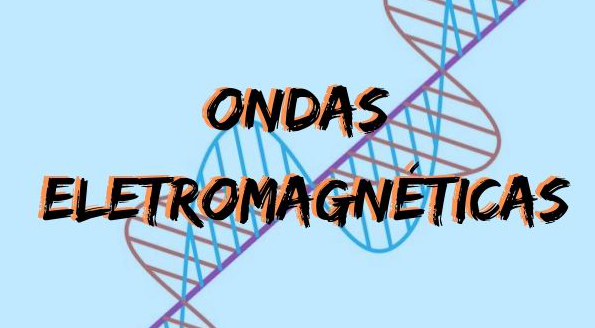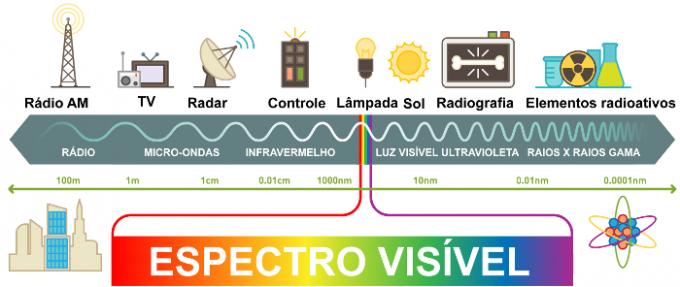waveselectromagnetic are oscillations formed by electric fieldsand magneticvariables, which propagate both in a vacuum and in material media. They are three-dimensional and transverse waves that travel in the speed of light, carrying exclusively energy. Furthermore, they come in the form of radio waves, microwaves, infrared, visible light, ultraviolet, x-rays and gamma rays, in ascending order of frequency and energy.
Before we continue, we suggest that you read our article and get to know some important concepts about wave classification.
What are electromagnetic waves?
Electromagnetic waves arise based on the interaction between changing electric fields or magnetic fields. These propagate in a vacuum at the same speed as light, about 300,000 kilometers per second. Unlike mechanical waves, such as the sound, electromagnetic waves can propagate both in material media and in a vacuum. Because they are wave phenomena, they can undergo reflection, refraction, absorption, diffraction, interference, scattering and polarization.

Electromagnetic waves were predicted and theorized by the Scottish physicist and mathematician JamesClerkMaxwell, that unified the equations of electricity It's from magnetism existing equations (Equations of Faraday, Ampere and Gauss) in wave equations.
Know more:Michel Faraday – one of the greatest experimentalists in history!
Through his equations, Maxwell was able to calculate the modulus of propagation speed of the waveselectromagnetic. Experimental confirmation of the existence of electromagnetic waves only appeared about a decade later, after experiments carried out by the German physicist HeinrichHertz.
All electromagnetic waves have frequency of oscillation, lengthinwave and amplitude. Also, wavelength and frequency are quantities inverselyproportional, therefore, high frequency waves such as x-rays or gamma, had very small lengths. The following figure shows the electromagnetic spectrum and the different ranges of existing electromagnetic waves, note:

Characteristics of electromagnetic waves
Some characteristics of electromagnetic waves:
- They are transversals, that is, the disturbance responsible for producing them happens in a directionperpendicular to its propagation direction. In electromagnetic waves, the electric field, the magnetic field and the propagation direction are perpendicular to each other;
- They propagate in a vacuum at the same speed as visible light: 2,99792458.108 m/s, symbolized by the letter c;
- Your amplitude concerns your intensity, the greater the amplitude of an electromagnetic wave, the greater the disturbance it is capable of producing;
- They are three-dimensional, that is, after being produced, they propagate equally in all directions;
- When they pass through material media, such as air or water, their propagation speed decreases, while your wave-length increases, so your frequency does not change. This phenomenon is known as refraction.
See too: What are waves for physics? Check exercises and mind map
Electromagnetic waves in everyday life
Check out some examples of existing electromagnetic waves that are widely used in our daily lives:
- Radio waves: are widely used in telecommunications. The radio, television and cell phone signal is in this frequency range;
- Microwave: they are also widely used in telecommunications. Wireless internet routers, popularly known as Wi-Fi, use microwave frequencies ranging between 2.4 GHz and 5.8 GHz;
- Infra-red: It is also known as a heat wave. Some security devices equipped with night vision are able to pick it up. Infrared is the wave emitted when using a remote control;
- Visible light: it is the range of electromagnetic waves located between the frequencies of 480 THz and 750 THz.
- Ultraviolet: after certain frequencies, it is considered to be ionizing radiation, that is, an electromagnetic wave with the potential to start. electrons of the molecules, causing the appearance of cellular anomalies that can evolve into a cancer, for example. This electromagnetic wave frequency is widely used by criminal experts to detect biological materials such as blood and saliva; its ionization capacity also allows it to be used for the sterilization of surgical utensils, syringes, containers, etc.;
- Raysx: arrive on Earth in small numbers due to the presence of earth atmosphere. These electromagnetic waves have very high frequencies and great penetration power, so they are used to obtain images of bones and joints and for the treatment of tumors, through gives radiotherapy
See more:X-rays - high frequency electromagnetic radiation
- Gamma: are produced by nuclear reactions, in which the core energy levels of the atoms vary. These waves are extremely energetic and have high penetration power. Gamma rays are used for astronomical studies and for inducing nuclear reactions.
Electromagnetic waves and matter
How electromagnetic waves interact with matter depends directly on their frequency. Check how electrical charges and other particles respond to each type of wave:
- wavesinradio: promote the collective oscillation of free electrons in metals, as occurs in antennas used in radios and televisions;
- Microwave: have frequencies similar to the rotation frequency of water molecules, this makes this type of electromagnetic wave can resonate with these molecules, heating them through the rotation;
- Infra-red: promotes molecular vibration, is one of the main forms of heat transmission;
- Visible light: it is able to supply energy and excite the electrons present in molecules;
- Ultraviolet: promotes the excitation of electrons but can also cause the ejection of electrons that are in the valence layer of atoms;
- X ray: they are able to rip electrons from atoms by elastic collision between photons and atoms. These photons are absorbed by atoms and re-emitted at lower frequencies;
- Raysgamma: they can cause nuclear excitations, leading to their dissociation, but they can also generate matter and antimatter pairs, causing the mutual annihilation of these particles.
By Rafael Hellerbrock
Physics teacher
Source: Brazil School - https://brasilescola.uol.com.br/fisica/o-que-sao-ondas-eletromagneticas.htm

